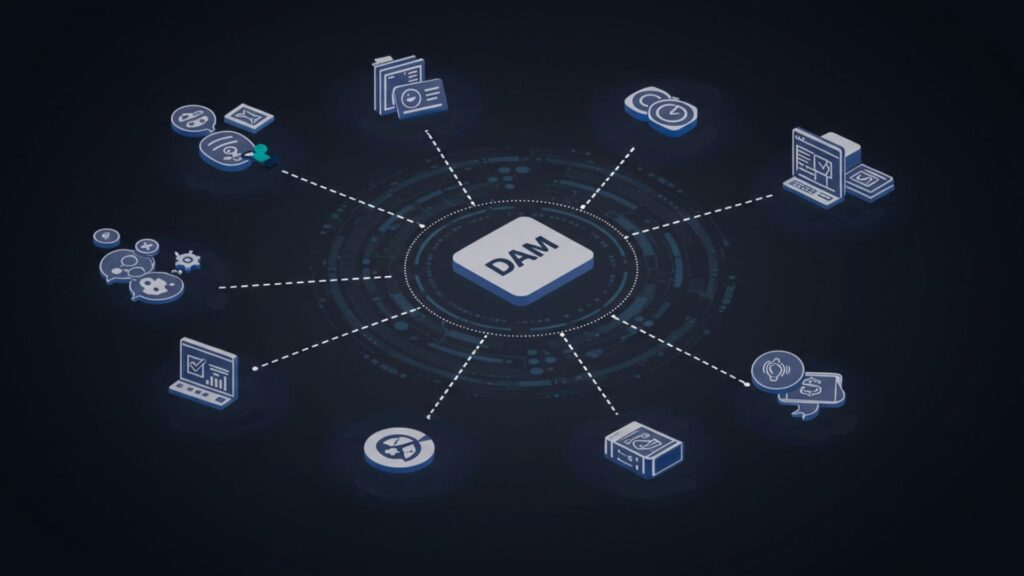Marketing and creative teams are under increasing pressure to deliver personalized, brand-consistent experiences at scale. As the volume of digital content grows, so does the complexity of managing it. From campaign assets to product imagery, ensuring your teams can quickly find, use, and repurpose content across channels is essential to staying competitive and agile.
Conducting a smart DAM software comparison becomes critical. While storage is important, choosing the right digital asset management solution is about enabling streamlined collaboration, supporting governance, and accelerating time-to-market.
Whether you’re overseeing global campaigns or managing localized content, understanding the capabilities and differences between leading DAM systems can help ensure you select the platform that aligns with your strategy, scales with your business, and empowers your teams to do their best work.
DAM Software Comparison: What to Consider Before You Choose
When evaluating a DAM software comparison, look beyond surface-level features and dig into the real-world capabilities that will help your team manage digital assets more effectively. A robust digital asset management solution should serve as a comprehensive content hub that empowers your creative and marketing teams to collaborate, distribute assets, and maintain brand consistency across all channels.
Let’s break down the key elements to assess when comparing digital asset management systems.
Scalability for Your Team’s Future Needs
As your organization grows and produces more digital content, your DAM system must grow with you. Look for solutions that support unlimited users, increasing volumes of visual content, and advanced features like AI-driven metadata tagging or automated approval workflows. A scalable digital asset management platform ensures you’re not switching systems every few years, saving both time and resources.
Integration With Existing Martech Stack
The best digital asset management software doesn’t operate in a silo. It should offer seamless integration with tools your teams already use, such as Adobe Creative Cloud, content management systems, and marketing automation platforms. You can streamline your creative process by enabling users to work within their preferred environments while still tapping into a central location for all your digital files.

User Experience and Interface Usability
A user-friendly interface drives adoption across internal and external stakeholders. If your DAM platform is overly technical or clunky, it will create bottlenecks instead of solving them.
Look for digital asset management systems that are intuitive, easy to navigate, and designed for both tech-savvy digital asset managers and non-technical users on marketing teams or among external partners.
Security and Governance Capabilities
Managing your organization’s digital assets means securing them as well. Choose DAM software that offers enterprise-grade security, with features like granular access controls, role-based permissions, and audit trails. These capabilities protect sensitive brand assets, ensure compliance with brand guidelines, and allow you to safely share assets with internal or external users while maintaining control.
Digital Asset Management Features That Drive Efficiency
An effective digital asset management solution helps teams move faster, collaborate better, and deliver digital experiences at scale. The right feature set can transform your asset management efforts by improving asset retrieval, reducing time spent on manual tasks, and ensuring that the right people have access to the most relevant assets at the right time.
Here are the key features that drive efficiency in today’s best DAM tools.
Metadata Management and Smart Tagging
Proper metadata management is the backbone of any effective digital asset management system. Features like automated tagging, custom metadata fields, and taxonomy support make it easier to organize and locate digital assets, especially when you’re managing thousands of visual assets across departments. Smart metadata capabilities also improve search functionality, helping teams quickly find and reuse content instead of recreating it.
AI-Powered Search and Discovery
When time is of the essence, having advanced search is a game-changer. Look for DAM software that uses AI and machine learning to enhance its search functionality, making it possible to locate creative assets based on context, visual elements, or usage history. Reducing friction in the creative process helps teams surface high-performing brand assets quickly and confidently.
Workflow Automation and Version Control
The best asset management software includes built-in workflow automation and version control to streamline project approvals, content updates, and creative reviews. Automated workflows eliminate repetitive tasks and reduce human error, while versioning ensures everyone is working with the most current file. These features support advanced workflow automation and help enforce brand guidelines throughout content production.
Cross-Functional Collaboration
Efficient digital asset management encourages collaboration between creative teams, marketing teams, and external partners. Built-in collaboration features like comments, annotations, and approval workflows enable real-time communication across departments. Having all stakeholders aligned reduces delays and makes it easier to manage digital assets across multiple channels and audiences.
DAM System Benefits for Marketing and Creative Teams
Think about the last time your team had to track down a final version of a campaign image—or worse, recreated a graphic from scratch because no one could find the original. If that sounds familiar, you’re not alone.
Many teams struggle with asset storage, versioning issues, and inconsistent branding simply because they lack a centralized, intelligent way to manage digital assets. A modern DAM system solves these challenges by supporting the full content lifecycle while helping teams move faster and smarter.

Accelerated Campaign Execution
Speed matters, especially when content demand is high. A well-configured digital asset management solution reduces time spent searching for files and chasing down approvals, freeing up your teams to focus on strategy and creativity.
Just look at Hachette Book Group, which consolidated 40 terabytes of digital assets from 18 siloed locations into a single digital asset management platform. By streamlining access to creative files, their teams dramatically improved productivity and reduced turnaround time for marketing campaigns and book launches.
Centralized Access to Brand Consistency
A DAM platform acts as the single source of truth for all your digital content, making it easier for internal and external stakeholders to access the latest materials.
Whether you’re in the office or working remotely, you can quickly find, preview, and share assets without worrying about outdated files or incorrect branding. Teams managing high volumes of visual content like product images, promotional banners, or social media graphics find this especially valuable.
Better Brand Management, Content Governance, and Control
Governance often gets overlooked until a mistake is made like an embargoed product image getting posted too early. A solid digital asset manager comes with granular access controls, automated permissions, and audit trails to prevent these kinds of errors. You can restrict usage based on role, region, or asset type, making it easy to protect sensitive files and meet compliance needs without sacrificing usability.
Actionable Insights Into Asset Usage
Beyond storage and access, modern DAM software gives you visibility into how your assets are being used. You can analyze asset usage across teams and regions to identify top-performing content or understand what’s underutilized. These insights help optimize your asset management efforts, prioritize content investments, and fine-tune your overall content strategy.
Evaluating DAM Tools: Usability, Support, and Customization
While many platforms offer similar core features, it’s the experience around those features that often determines whether the solution actually works for your team. Usability, support, and customization are elements that impact adoption, long-term ROI, and your ability to scale over time.
Below are key areas to focus on when comparing asset management software options.
Role-Based Permissions and Custom Workflows
Your DAM should adapt to how your teams actually work, not the other way around. Look for a digital asset management platform that offers configurable workflows and granular access controls, allowing you to tailor asset reviews, approvals, and sharing based on roles or departments.
For example, your legal team might only need access to the final creative, while product marketing requires visibility into assets at every stage. Customization protects sensitive content while improving efficiency across teams.
Mobile and Remote Access Capabilities
In an increasingly hybrid world, mobile functionality is no longer optional. Whether a brand manager is on a shoot or a sales rep needs content on the go, your DAM software should make it easy to retrieve assets from anywhere. Platforms with dedicated mobile apps or responsive interfaces support faster decision-making and enable global content delivery networks to function seamlessly, regardless of time zone or device.

Vendor Support and Implementation Services
Even the best DAM software can fall flat without the right onboarding and support. Choose a vendor that provides hands-on implementation guidance, training resources, and responsive customer service. Bonus points if they offer a dedicated success manager who can help your team refine your taxonomy, build governance frameworks, and ensure you’re using advanced features effectively. This is especially important for organizations that don’t have extensive technical expertise in-house.
Comparing the Best DAM Software Platforms
Once you’ve identified your must-have features and technical requirements, it’s time to compare the leading digital asset management platforms side by side. The key here is to align platform strengths with your team’s specific goals, whether it’s scaling global operations, improving collaboration across departments, or enhancing visibility into asset usage.
A smart DAM software comparison goes beyond features to evaluate usability, industry fit, and long-term flexibility.
Feature Matrix: Side-by-Side Comparison
Start by building a feature matrix that evaluates the core capabilities of each DAM platform. Focus on items like workflow automation, version control, metadata management, collaboration features, and seamless integration with tools like Adobe Creative Cloud or your content management systems. You can visualize where each platform excels and where compromises may be required.
Industry Use Cases and Case Studies
Not all DAM solutions are built with the same audience in mind. Some platforms are tailored to enterprise marketing teams with complex approval structures, while others cater to media-rich environments like publishing or retail.
Look for vendor case studies and success stories in industries similar to yours to understand how each solution performs in real-world environments. For instance, a DAM used by a global publisher with thousands of creative files might not be the best fit for a mid-sized B2B brand focused on targeted, account-based marketing.
Pricing Models and Flexibility
Cost can vary widely among digital asset management systems, so be sure to understand what you’re paying for. Does the platform charge based on storage volume, number of users, or advanced functionality? Be mindful of vendors that offer tiered pricing with limitations on storage or users, especially if you anticipate growth.
The best DAM software will offer flexible plans that support unlimited users, scalable storage, and long-term ROI, without punishing you for scaling your content operations.
How to Choose DAM Solutions That Match Your Strategy
Selecting digital asset management software is about aligning your tools with your team’s long-term goals. Whether you’re focused on speeding up campaign production, improving collaboration across global teams, or enforcing brand consistency, your DAM choice should support your strategy today and scale with you tomorrow. Here’s a quick checklist to guide your decision:
- Ensure the platform integrates easily with your existing content management systems, creative tools, and martech stack.
- Confirm that it supports your brand management goals with templates, approval workflows, and governance structures.
- Look for analytics to analyze asset usage and inform smarter content decisions.
- Verify flexible pricing and licensing models that won’t restrict growth or charge extra for unlimited users.
- Choose a vendor that offers strong onboarding, responsive support, and configuration guidance, especially if your team lacks deep technical expertise.
- Prioritize a user-friendly interface so your marketing and creative teams can get up to speed quickly and work more efficiently.
The right DAM is a long-term partner in your content operations strategy.
Making the Right DAM Software Investment
Comparing digital asset management software is a strategic move, not just a tech upgrade. The right solution empowers your teams to effectively create, manage, and distribute assets while maintaining brand consistency across every channel and touchpoint. Investing in the right DAM software means fewer bottlenecks, better governance, and faster content delivery.At Aprimo, we understand that managing content enables users to do more with every asset. Our platform combines enterprise-grade security, seamless integration with the tools you already use, and configurable workflows that adapt to your unique processes. We help teams manage, govern, and optimize all your digital assets from a single, intelligent hub. Request a personalized demo today to see how Aprimo can help you deliver smarter content experiences.


